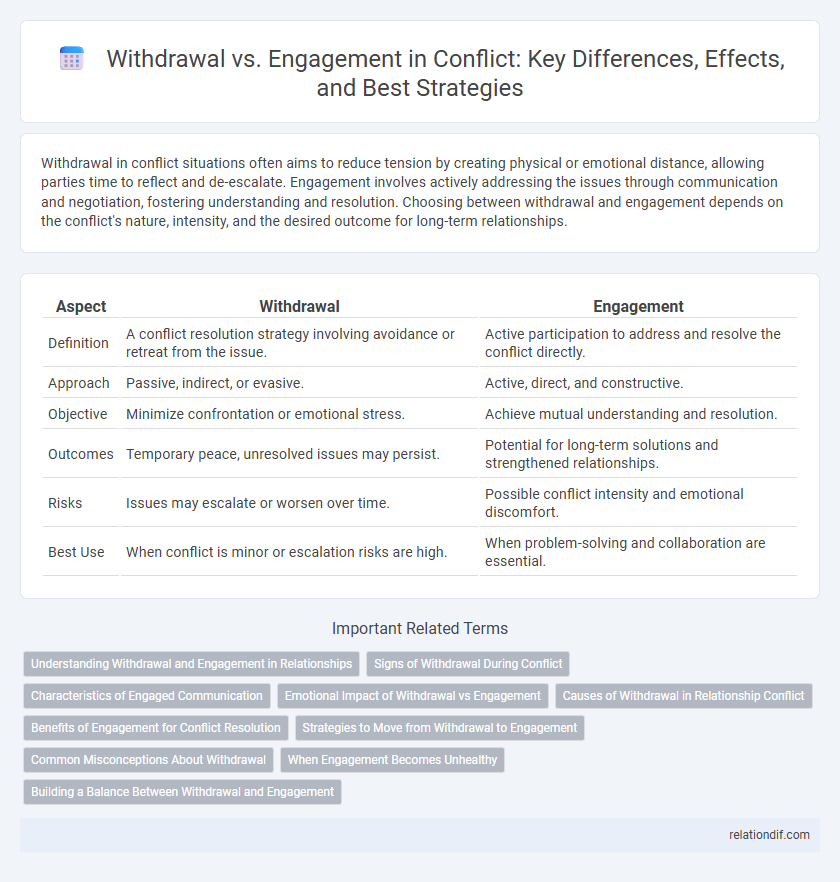Withdrawal in conflict situations often aims to reduce tension by creating physical or emotional distance, allowing parties time to reflect and de-escalate. Engagement involves actively addressing the issues through communication and negotiation, fostering understanding and resolution. Choosing between withdrawal and engagement depends on the conflict's nature, intensity, and the desired outcome for long-term relationships.
Table of Comparison
| Aspect | Withdrawal | Engagement |
|---|---|---|
| Definition | A conflict resolution strategy involving avoidance or retreat from the issue. | Active participation to address and resolve the conflict directly. |
| Approach | Passive, indirect, or evasive. | Active, direct, and constructive. |
| Objective | Minimize confrontation or emotional stress. | Achieve mutual understanding and resolution. |
| Outcomes | Temporary peace, unresolved issues may persist. | Potential for long-term solutions and strengthened relationships. |
| Risks | Issues may escalate or worsen over time. | Possible conflict intensity and emotional discomfort. |
| Best Use | When conflict is minor or escalation risks are high. | When problem-solving and collaboration are essential. |
Understanding Withdrawal and Engagement in Relationships
Withdrawal in relationships often stems from emotional overwhelm or fear of confrontation, leading individuals to avoid conflict and reduce communication. Engagement involves actively addressing issues through open dialogue and empathetic listening, fostering mutual understanding and resolution. Balancing withdrawal and engagement is crucial for maintaining healthy relational dynamics and preventing prolonged misunderstandings.
Signs of Withdrawal During Conflict
Signs of withdrawal during conflict often include avoidance of communication, reduced emotional expression, and physical distancing from the situation or individuals involved. Individuals may exhibit silence, minimal participation, or disengagement that hinders resolution and escalates tension. Recognizing these behaviors early can inform strategies to re-engage and address underlying issues effectively.
Characteristics of Engaged Communication
Engaged communication in conflict emphasizes active listening, empathy, and open dialogue to foster mutual understanding and cooperation. It involves clear expression of thoughts and feelings while attentively responding to the other party's perspectives. This approach promotes collaboration, reduces misunderstandings, and facilitates effective conflict resolution.
Emotional Impact of Withdrawal vs Engagement
Withdrawal during conflict often leads to feelings of isolation and unresolved tension, amplifying emotional distress and reducing opportunities for mutual understanding. Engagement fosters open communication, facilitating emotional expression and promoting empathy, which can strengthen relationships and resolve disagreements more effectively. The choice between withdrawal and engagement directly influences the emotional climate, with engagement typically contributing to healthier conflict resolution and emotional well-being.
Causes of Withdrawal in Relationship Conflict
Withdrawal in relationship conflict often stems from fear of confrontation, emotional exhaustion, or perceived lack of resolution, leading individuals to retreat instead of addressing issues. Avoidance behaviors can escalate misunderstandings and reduce opportunities for constructive communication, further deepening emotional distance between partners. Chronic withdrawal may signal underlying issues such as low trust, unresolved past conflicts, or incompatible communication styles that hinder conflict resolution.
Benefits of Engagement for Conflict Resolution
Engagement in conflict resolution fosters open communication, which promotes mutual understanding and reduces misinterpretations between parties. Active participation enables collaborative problem-solving, leading to sustainable and mutually beneficial agreements. Furthermore, engagement helps build trust and empathy, creating a foundation for long-term peace and preventing future disputes.
Strategies to Move from Withdrawal to Engagement
Effective strategies to move from withdrawal to engagement in conflict involve fostering open communication channels and encouraging active listening to build trust between parties. Implementing conflict resolution techniques such as mediation and collaborative problem-solving helps address underlying issues and promotes mutual understanding. Establishing clear goals and shared interests supports sustained participation and commitment to resolving disputes constructively.
Common Misconceptions About Withdrawal
Withdrawal from conflict is often misconstrued as passive avoidance or weakness, yet it can represent a strategic retreat to de-escalate tensions or preserve resources. Many believe engagement always leads to resolution, but mismanaged confrontation can exacerbate hostility and prolong disputes. Effective conflict management recognizes when withdrawal fosters reflection and opens pathways for future constructive dialogue.
When Engagement Becomes Unhealthy
Engagement in conflict becomes unhealthy when it leads to emotional exhaustion, perpetuates cycles of blame, and hinders resolution by escalating tensions instead of fostering understanding. Persistent unhealthy engagement can result in entrenched hostility and deteriorate relationships, making withdrawal a necessary strategy for self-preservation and conflict de-escalation. Recognizing the tipping point where engagement shifts from constructive dialogue to destructive interaction is crucial for effective conflict management.
Building a Balance Between Withdrawal and Engagement
Building a balance between withdrawal and engagement in conflict management involves recognizing the strategic value of both approaches to preserve relationships and maintain personal well-being. Tactical withdrawal can prevent escalation and provide time for reflection, while active engagement facilitates resolution and mutual understanding. Effectively alternating between withdrawal and engagement supports adaptive conflict responses aligned with situational demands and long-term goals.
Withdrawal vs engagement Infographic

 relationdif.com
relationdif.com